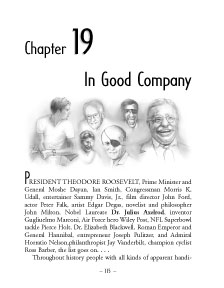 |
| Those of us who have lost an eye are in good company. In this final chapter of his book, Mr. Brady provides an impressive list of successful figures having a "singular view:" Theodore Roosevelt, Moshe Dayan, Ian Smith, Morris K. Udall, Sammy Davis Jr., John Ford, Peter Falk, Hilaire Germain Edgar Degas, John Milton, Julius Axelrod, Gugliuelmo Marconi, Wiley Post, Pierce Holt, Elizabeth Blackwell, Hannibal, and Horratio Nelson. About Nelson, he writes: [Neslon was] The greatest of British naval heroes, whose victory at Trafalgar occurred more than 10 years after he lost his right eye in the battle off Corsica. Nelson even used his blind eye to advantage in the historic Battle of Copenhagen in 1801. His superior, Sir Hyde Parker, had signaled him to halt his attack on a Danish ship against what Parker considered very dubious odds. Nelson placed a telescope against his blind eye, and after a careful 'look', told his aide, "I do not see the signal." He then proceeded with the attack, which was soon to become a major chapter in Britain's proud naval history. Thus Nelson used his handicap to turn a potential defeat into a resounding victory.Go, and do thou likewise.(pg. 131) Chapter 1. An Unhappy Landing Chapter 2. An Awkward Takeoff Chapter 3. Jolts of Reality Chapter 4. Flying High Chapter 5. How About You? Chapter 6. Seeing in 3-D—How It Works Chapter 7. What Has Changed? Chapter 8. Getting Back to 3-D Chapter 9. Avoiding Problems and Possible Mistakes Chapter 10. In the Driver’s Seat Chapter 11. The Active Life Chapter 12. Let Technology Help Chapter 13. Keeping the Good Eye Good Chapter 14. Seeing to Your Looks Chapter 15. Eye-making (Ocularistry) Chapter 16. Driving and Piloting Licenses Chapter 17. For Parents Only Chapter 18. Senior Class Chapter 19. In Good Company Glossary Resources |